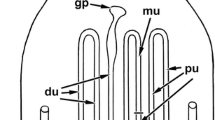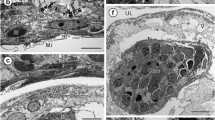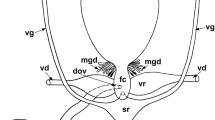Abstract
The members of the order Gyrocotylidea are monozoic tapeworms and generally considered to be the most primitive group of the Cestoda in terms of the evolution of this platyhelminth class. As part of a series of ultrastructural studies on Gyrocotyle urna (Wagener, 1852), three regions of the uterus were distinguished. The proximal region of the uterus is characterised by underlying perikarya, the presence of septate junctions within the epithelial wall and two types of specialised outer coverings, lamellae and cilia. The middle, syncytial region of the uterus is covered by short lamellae and marked by a concentration of sunken glandular perikarya (uterine glands). Glandular spheroidal granules (c.0.45 μm in diameter) of moderately dense content and a fine fibrillar texture are liberated by migration through the luminal membrane. The epithelium of the sac-shaped, distal region of the uterine duct is interrupted by cytoplasmic processes of sunken epithelial bodies, covered with lamellae and contains septate junctions. A muscular sphincter surrounds the narrow, terminal region of the distal uterine duct. The ultrastructural pattern of the uterus of the Gyrocotylidea has important discriminating traits (i.e. the presence of sunken perikarya along its entire length, septate junctions within the uterine epithelial cytoplasm of the proximal and distal regions, and cilia on the surface of its proximal region) unique among the Neodermata and which may represent autapomorphic character states for the group.




Similar content being viewed by others
References
Awad, A. H. H., & Probert, A. J. (1990). Scanning and transmission electron microscopy of the female reproductive system of Schistosoma margrebowiei Le Roux, 1933. Journal of Helminthology, 64, 181–192.
Bandoni, S. M., & Brooks, D. R. (1987). Revision and phylogenetic analysis of the Gyrocotylidea Poche, 1926 (Platyhelminthes: Cercomeria: Cercomeromorpha). Canadian Journal of Zoology, 65, 2369–2388.
Brooks, D. R., O’Grady, R. T., & Glen, D. R. (1985). The phylogeny of the Cercomeria Brooks, 1982 (Platyhelminthes). Proceedings of the Helminthological Society of Washington, 52, 1–20.
Bychowsky, B. E. (1957). [The monogenetic trematodes, their systematics and phylogeny.] Moscow-Leningrad: Akademii Nauk SSSR, 509 pp. (In Russian).
Cable, J., & Tinsley, R. C. (1991). Intra-uterine larval development of the polystomatid monogeneans, Pseudodiplorchis americanus and Neodiplorchis scaphiopodis. Parasitology, 103, 253–266.
Conn, D. B. (1987). Fine structure, development, and senescence of the uterine epithelium of Mesocestoides lineatus (Cestoda: Cyclophyllidea). Transactions of the American Microscopical Society, 106, 63–73.
Conn, D. B. (1993). Ultrastructure of the gravid uterus of Hymenolepis diminuta (Platyhelminthes: Cestoda). Journal of Parasitology, 79, 583–590.
Conn, D. B., & Etges, F. (1984). Fine structure and histochemistry of the parenchyma and uterine egg capsules of Oochoristica anolis (Cestoda: Linstowiidae). Zeitschrift für Parasitenkunde, 70, 769–779.
Conn, D. B., & Forman, L. A. (1993). Morphology and fine structure of the gravid uterus of three hymenolepidid tapeworm species (Platyhelminthes: Cestoda). Invertebrate Reproduction and Development, 23, 95–103.
Davydov, V. G., & Korneva, J. V. (2000). Differentiation and structure of a uterus for Nippotaenia mogurndae Yamaguti et Miyato, 1940 (Cestoda: Nippotaeniidea). Helminthologia, 37, 77–82.
Davydov, V. G., & Poddubnaya, L. G. (1988). Functional morphology of the frontal and uterine glands in cestodes of the order Caryophyllidea. Parazitologiya, 22, 449–457. (In Russian).
Davydov, V. G., Poddubnaya, L. G., & Kolesnikova, G. A. (1994). Ultrastructure of genital system ducts of Caryophyllaeus laticeps (Cestoda, Caryophyllidea). Parazitologiya, 28, 501–509. (In Russian).
Davydov, V. G., Poddubnaya, L. G., & Kuperman, B. I. (1997). An ultrastructure of some systems of the Diplocotyle olrikii (Cestoda: Cyathocephalata) in relation to peculiarities of its life cycle. Parazitologiya, 31, 132–141. (In Russian).
Ehlers, U. (1985). Phylogenetic relationship within the Platyhelminthes. In S. Conway Morris, J. D. George, R. Gibson, & H. M. Platt (Eds.), The origin and relationships of lower invertebrates (pp. 143–158). Oxford: Oxford University Press.
Erasmus, D. A. (1973). A comparative study of the reproductive system of mature, immature and ‘unisexual’ female Schistosoma mansoni. Parasitology, 67, 165–183.
Galaktionov, K. V., & Dobrovolskii, A. A. (1987). [Hermaphroditic generation of trematodes.] Leningrad: Nauka, 192 pp. (In Russian).
Galkin, A. A. (1999). Position of Amphilinidea in the system of Cercomeromorphae. Parazitologiya, 33, 497–506. (In Russian).
Gibson, D. I. (1987). Questions in digenean systematics and evolution. Parasitology (Trends and Perspectives), 95, 429–460.
Gibson, D. I. (1994). Order Gyrocotylidea Poche, 1926. In L. F. Khalil, A. Jones, & R. A. Bray (Eds.), Keys to the cestode parasites of vertebrates (pp. 11–13). Wallingford, UK: CAB International.
Gibson, D. I., & Bray, R. A. (1979). The Hemiuroidea: terminology, systematics and evolution. Bulletin of the British Museum (Natural History) (Zoology), 36, 35–146.
Ginetsinskaya, T. A., & Dobrovolskii, A. A. (1978). [Special parasitology. Parasitic worms, Mollusca and Arthropoda.] Vol. 2. Moscow: Vysshaja Shkola, 292 pp. (In Russian).
Gulyaev, V. D. (2002). Heterotopies of copulatory apparatus in phylogenesis of pseudophyllidomorphic tapeworms (Eucestoda). In A. K. Galkin & H. V. Dubinina (Eds.), Problems of cestodology (Vol. 2, pp. 83–96). St Petersburg: Zoological Institute, RAS. (In Russian).
Ivanov, A. V. (1991). The state of the art system of Plathelminthes. Zoologicheskii Zhurnal, 70, 5–19. (In Russian).
Jones, M. K. (1998). Structure and diversity of cestode epithelia. International Journal for Parasitology, 28, 913–923.
Jones, M. K., Ernst, I., & Whittington, I. D. (1998). The uterine epithelium of Gyrodactylus kobayashi: ultrastructure of basal matrices, cytoplasmic membranes and the birth plug, and comparison with other reproductive epithelia. International Journal for Parasitology, 28, 1805–1855.
Joyeux, C., & Baer, J.-G. (1961). Classe des Cestodes, Cestoidea Rudolphi. In P.-P. Grassé (Ed.), Traité de Zoologie (pp. 347–560). Paris: Masson et Cie.
Karling, T. G. (1940). Zur Morphologie und Systematic der Alloecoela cumulata und Rhabdocoela lecithophora (Turbellaria). Acta Zoologica Fennica, 26, 1–260.
Korneva, Zh. V. (2001). Ultrastructure of the female genital system in Proteocephalus torulosus and P. exiguus (Cestoda: Proteocephalidea). Helminthologia, 38, 67–74.
Korneva, Zh. V. (2002). Ultrastructural organization of reproductive system in Triaenophorus nodulosus (Cestoda, Pseudophyllidea). Zoologicheskii Zhurnal, 81, 1432–1438. (In Russian).
Korneva, Zh. V., & Davydov, V. G. (2001). The female reproductive system in the proteocephalidean cestode Gangesia parasiluri (Cestoda, Proteocephalidae). Zoologicheskii Zhurnal, 80, 131–144. (In Russian).
Llewellyn, J. (1965). The evolution of parasitic platyhelminths. In A. E. R. Taylor (Ed.), Evolution of parasites. Third Symposium of the British Society for Parasitology (pp. 47–78). Oxford: Blackwell Scientific Publications.
Llewellyn, J. (1986). Phylogenetic inference from platyhelminth life-cycle stages. In M. J. Howell (Ed.), Parasitology—quo vadit? Proceedings of the sixth international congress of parasitology (pp. 281–289), Brisbane. Canberra: Australian Academy of Sciences.
Lockyer, A. E., Olson, P. D., & Littlewood, D. T. J. (2003). Utility of complete large and small subunit rRNA genes in resolving the phylogeny of the Neodermata (Platyhelminthes): implications and a review of the cercomer theory. Biological Journal of the Linnaean Society, 78, 155–171.
Lynch, J. E. (1945). Redescription of the species of Gyrocotyle from the ratfish, Hydrolagus colliei (Lay and Bennet), with notes on the morphology and taxonomy of the genus. Journal of Parasitology, 31, 418–446.
Olson, P. D., Littlewood, D. T. J., Bray, R. A., & Mariaux, J. (2001). Interrelationships and evolution of the tapeworms (Platyhelminthes: Cestoda). Molecular Phylogenetics and Evolution, 19, 443–467.
Olson, P. D., Poddubnaya, L. G., Littlewood, D. T. J., & Scholz, T. (2008). On the position of Archigetes and its bearing on the early evolution of the tapeworms. Journal of Parasitology, 94, 898–904.
Park, J.-K., Kim, K. H., Kang, S., Kim, W., Eom, K., & Littlewood, D. T. J. (2007). A common origin of complex life cycles in parasitic flatworms: evidence from the complete mitochondrial genome of Microcotyle sebastis (Monogenea: Platyhelminthes). BioMed Central. Evolutionary Biology, 7, 11–24.
Poddubnaya, L. G. (2002). Ultrastructure of genital system ducts of Diphyllobothrium latum (Cestoda: Pseudophyllidea): the ducts of the female reproductive system. Parazitologiya, 36, 79–87. (In Russian).
Poddubnaya, L. G. (2003a). Structure of reproductive system of the amphicotylid cestode Eubothrium rugosum (Cestoda, Pseudophyllidea). Journal of Evolutionary Biochemistry and Physiology, 39, 345–355.
Poddubnaya, L. G. (2003b). Ultrastructure of reproductive organs and ducts in the progenetic species Archigetes sieboldi (Cestoda, Caryophyllidea). Zoologicheskii Zhurnal, 82, 1038–1050. (In Russian).
Poddubnaya, L. G., Bruňanská, M., Kuchta, R., & Scholz, T. (2006). First evidence of the presence of microtriches in the Gyrocotylidea. Journal of Parasitology, 92, 703–707.
Poddubnaya, L. G., Mackiewicz, J. S., Bruňanská, M., & Scholz, T. (2005). Fine structure of the female reproductive ducts of Cyathocephalus truncatus (Cestoda: Spathebothriidea), from salmonid fish. Folia Parasitologica, 52, 323–338.
Poddubnaya, L. G., Mackiewicz, J. S., & Kuperman, B. I. (2003). Ultrastructure of Archigetes sieboldi (Cestoda: Caryophyllidea): relationship between progenesis, development and evolution. Folia Parasitologica, 50, 275–292.
Poddubnaya, L. G., Scholz, T., Kuchta, R., Levron, C., & Gibson, D. I. (2008). Ultrastructure of the surface structures and secretory glands of the rosette attachment organ of Gyrocotyle urna (Cestoda: Gyrocotylidea). Folia Parasitologica, 55, 207–218.
Podvyaznaya, I. M. (1990). [The morphology and ultrastructure of the female reproductive system of Prosthodendrium ascidia (Trematoda, Lecithodendriidae)]. In Yu. V. Mamkaev & B. I. Joffe (Eds.) [Parasitic and free-living Plathelminthes: faunistics and morphology.] Trudy Zoologicheskii Instituta, Leningrad, 221, 61–78. (In Russian).
Podvyaznaya, I. M. (2003). Ultrastructural studies of the female reproductive system in a parasite of bats Allassogonoporus amphoraeformis (Digenea: Allassogonoporidae). Parazitologiya, 37, 387–393. (In Russian).
Rees, F. G. (1979). The morphology and ultrastructure of the female reproductive ducts of the metacercaria and adult of Cryptocotyle lingua (Creplin) (Digenea: Heterophyidae). Parasitology, 30, 1109–1113.
Roberts, L. S., & Janovy, J. (2005). Trematoda: Aspidobothrea. In L. S. Roberts & J. Janovy (Eds.), Gerald D. Schmidt & Larry Roberts’ Foundations of Parasitology (pp. 209–216). New York: McGraw-Hill.
Rohde, K. (1994). The origins of parasitism in the Platyhelminthes. International Journal for Parasitology, 24, 1099–1115.
Rohde, K., Johnson, A. M., Baverstock, P. R., & Watson, N. A. (1995). Aspects of the phylogeny of Platyhelminthes based on 18S ribosomal DNA and protonephridial ultrastructure. Hydrobiologia, 305, 27–35.
Świderski, Z., & Tkach, V. (1997). Differentiation and ultrastructure of the paruterine organs and paruterine capsules in the nematotaeniid cestode Nematotaenia dispar (Goeze, 1782) Lühe, 1910, a parasite of amphibians. International Journal for Parasitology, 27, 635–644.
Świderski, Z., & Xylander, W. (2000). Vitellocytes and vitellogenesis in cestodes in relation to embryonic development, egg production and life cycle. International Journal for Parasitology, 30, 805–817.
Thulin, J. (1982). Structure and function of the female reproductive ducts of the fish blood-fluke Aporocotyle simplex Odhner, 1900 (Digenea: Sanguinicolidae). Sarsia, 67, 227–248.
Waeschenbach, A., Webster, B. L., Bray, R. A., & Littlewood, D. T. J. (2007). Added resolution among ordinal level relationship of tapeworms (Platyhelminthes: Cestoda) with complete small and large subunit nuclear ribosomal RNA genes. Molecular Phylogeny and Evolution, 45, 311–325.
Wardle, R. A., & McLeod, J. A. (1952). The zoology of tapeworms. Minneapolis: Minnesota Press, 780 pp.
Watson, E. E. (1911). The genus Gyrocotyle, and its significance for problems of cestode structure and phylogeny. University of California Publications in Zoology, 6, 353–468.
Wittrock, D. D. (1982). Structure and origin of the eggshell of Quinqueserialis quinqueserialis (Trematoda, Notocotylidae). Zeitschrift für Parasitenkunde, 67, 37–44.
Xylander, W. E. R. (1987). Ultrastructural studies on the reproductive system of Gyrocotylidea and Amphilinidea (Cestoda). II. Vitellaria, vitellocyte development and vitelloduct of Gyrocotyle urna. Zoomorphology, 107, 293–297.
Xylander, W. E. R. (2001). The Gyrocotylidea, Amphilinidea and the early evolution of Cestoda. In D. T. J. Littlewood & R. A. Bray (Eds.), Interrelationships of the Platyhelminthes (pp. 103–111). London: Taylor & Francis.
Acknowledgments
The present study was supported by the Russian Foundation for Fundamental research project no.09-04-00342a and by the American Society of Parasitologists Boris Kuperman Memorial Fund to L.P. during 2007. It was also partly supported by the Grant Agency of the Czech Republic (Projects Nos 524/08/0885 and 524/07/P039) and the Institute of Parasitology, Czech Academy of Sciences (Projects Nos Z60220518 and LC522). The authors would like to thanks the staff of the Centre of Electron Microscopy, Institute of Biology of Inland Waters, Borok, Russia.
Author information
Authors and Affiliations
Corresponding author
Rights and permissions
About this article
Cite this article
Poddubnaya, L.G., Kuchta, R., Levron, C. et al. The unique ultrastructure of the uterus of the Gyrocotylidea Poche, 1926 (Cestoda) and its phylogenetic implications. Syst Parasitol 74, 81–93 (2009). https://doi.org/10.1007/s11230-009-9195-5
Received:
Revised:
Accepted:
Published:
Issue Date:
DOI: https://doi.org/10.1007/s11230-009-9195-5




